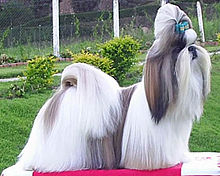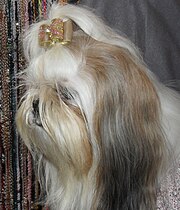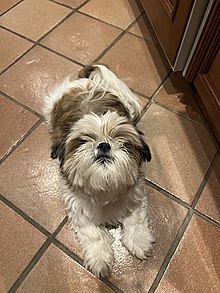Shih Tzu
| Shih Tzu | |||||||||||||||||||||||||||
|---|---|---|---|---|---|---|---|---|---|---|---|---|---|---|---|---|---|---|---|---|---|---|---|---|---|---|---|
 A Shih Tzu in full show coat | |||||||||||||||||||||||||||
| Other names | Chrysanthemum Dog | ||||||||||||||||||||||||||
| Origin | China | ||||||||||||||||||||||||||
| |||||||||||||||||||||||||||
| |||||||||||||||||||||||||||
| Dog ( domestic dog ) | |||||||||||||||||||||||||||
| Shih Tzu | |||||
Tibetan name | |||||
|---|---|---|---|---|---|
| Tibetan | |||||
| |||||
The Shih Tzu (.
They can adapt well to different situations. Due to their highly independent nature, they are not considered as a very obedient breed.[2]
Description
The Shih Tzu is a sturdy little dog with a small
Etymology
The name comes from the
("lion").

In contemporary Mandarin, the Shih Tzu is generally known as the "Xi Shi dog"; Xi Shi was regarded as one of the most beautiful women of ancient China. Shih Tzu was nicknamed the "chrysanthemum dog" in England in the 1930s.[6] The dog may also be called the Tibetan Lion Dog, but whether the breed should be referred to as "Tibetan" or "Chinese" is a source of both historical and political contention. A book on the breed states that "dog historians tend to have very strong opinions" on the subject.[7]
History
One theory is that the Shih Tzu descended from a cross between the

Shih Tzus and Buddhist mythology
Shih Tzus are largely associated with Buddhism and Buddhist mythology. The name "Shih Tzu" in Mandarin directly translates to "little lion," an animal considered sacred in Buddhist religion. Lions symbolize royalty, strength, and bravery – "fear nothing, and act without delay."[14] Pairs of stone lions or lion dogs located outside guard palace doors, tombs, temples, and public buildings are thought to protect these buildings from harmful individuals and spiritual influences.[14] These stone statues are often called Fu (or Foo) dogs, and it is suggested that these are the lionized form of the Shih Tzu.[15] "Fu" roughly translates to "happiness" in Manchurian, with legend stating Fu dogs are happy Shih Tzus forever guarding the temple of Buddha.[15] Fu dog statues typically represent a male and female Shih Tzu, carved out of stone, jade, teak, ivory, cinnabar, bronze, or ceramics.[16] The male dog is often seen holding a ball with his left paw and the female dog holds her puppy. Sources state this holds a symbolic meaning, with the male dog representing powers over nature, energy, wisdom, and precious stones and the female dog symbolizing protection, play, and a disciplinary attitude.[16]

Buddhists consider Shih Tzus blessed by and sacred beasts of Buddha. Legend states Buddha rode to earth on a lion and carried with him a small lion dog which accompanied him everywhere he went.[15] Legends vary across different sources, however many cite the Shih Tzu accompanied the Buddha of wisdom, Manjushri.[16] This lion dog had the ability to turn himself into a lion to carry Manjushri on his back. The physical features of Shih Tzus serve as proof of the eternal connection between Buddha and this breed. According to legend, several robbers surrounded Buddha with the intention of robbing and murdering him when the Shih Tzu transformed into a ferocious lion so large that the robbers were scared and fled the scene.[15] As the Shih Tzu returned to its dog form, Buddha blessed him for his courage.[15] Many Shih Tzus reflect this blessing in the form of the "Star of Buddha", which may also be called "Buddha's kiss", represented as a white patch of hair on the top of dog's head. Markings on the dogs back is said to be the saddle Buddha used to ride the dog in its lion form.[17] Legends vary across sources, largely because legends are historically passed down by word-of-mouth. Some cite this mark on the head as the place where Buddha kissed the dog, giving it his blessing.[17] Other sources state Buddha laid his finger on the dog's forehead in blessing, giving it a flash of white hair on its forehead.[15]
Coat colors
The Shih Tzu comes in many colours. The following colours are recognised by
- black & white
- brindle
- brindle & white
- gold & white
- gold brindle
- gold brindle & white
- gold with black mask
- grey & white
- solid black
- solid gold
- liver
- liver & white
Additionally the following colours are recognised as existing within the breed but not being part of the standard these are: blue, cream, lilac, lilac & white, white, particolour.[18]


Health
A number of health issues, some of them hereditary, have been found in individual Shih Tzu, and are listed below. The popularity of the breed has allowed for extremely poor breeding in general, leading to generalized and lifelong diseases, often from a fairly early age.[citation needed]
Heart disease
Brachycephaly

The
Eye issues
It is very common for Shih Tzus to develop eye problems at any age, and even more so once they are older. Most veterinarians will recommend eye drops to assist with any eye irritations. Some dogs have allergies which cause excess discharge around the eye. Older Shih Tzu are known to develop cataracts which can be corrected with surgery. If not treated, the dog may become blind in the eye that has the

Ear issues
A very common issue for Shih Tzus is the development of ear infections, as they have a long coat and hair grows in their ears. If ears are not plucked and cleaned often, ear infections will reoccur and cause more serious health issues.[3]
Skin sensitivities
The Shih Tzu's skin is particularly sensitive and prone to allergies. They should ideally be bathed every two to six days to maintain hygiene and prevent skin irritations.[citation needed]
Life expectancy
A study in the United Kingdom found the life expectancy of the Shih Tzu to be 11 years, a few months below the average life expectancy of all dogs.[24] A Japanese study found the Shih Tzu to have a life expectancy of 15 years, above the 14 year average for all dogs.[25][a]
Variations
Kennel club differences
There is a difference between the Shih Tzu of the
The AKC (American Kennel Club) Shih-Tzu
- Their front legs (forequarters) are straight. Their hindquarters are muscular. Neither should be too short nor too long.
- The standard head is big and round and is set high with face looking forward or up.
- The neck and body are the most important and should not be exaggerated.
- The eyes are large and face the front.
- The shoulders of the American type of Shih-Tzu are frontal.[26]
Notes
- ^ The Japanese study reviewed cemetery data which is unlikely to have any records of still-births and altricial deaths whilst a veterinary clinic likely would have data on these.
See also
References
- ISBN 978-1-138-12566-7.
- ^ "Shih Tzu". www.petmd.com. Retrieved 30 October 2022.
- ^ from the original on 1 May 2021. Retrieved 11 March 2021.
- ^ a b c "Federation Cynologique Internationale Breed Standard" (PDF). Fci.be. Archived (PDF) from the original on 31 October 2017. Retrieved 11 December 2017.
- ISBN 0-7641-1043-8
- ISBN 0-470-08945-8quote: "Lady Brownrigg, who brought the first Shih Tzu into England, coined the phrase Chrysanthemum Dog."
- ISBN 0-470-08945-8quote: "...dogs related to the modern-day Shih Tzu probably came from Tibet, but how long they were there and how much influence they had on the present day Shih Tzu may never be known." The author then says, "Dog historians tend to have very strong opinions." It is often mistakenly said that the Shih Tzu is Chinese royalty.
- ^ ISBN 0-87605-624-9.
- ISBN 0-87605-309-6
- S2CID 241657460
- ^ "The Kennel Club". Archived from the original on 27 November 2016. Retrieved 26 November 2016.
- ^ American Kennel Club 2013 Dog Registration Statistics Historical Comparisons & Notable Trends Archived 17 January 2017 at the Wayback Machine, The American Kennel Club, Retrieved 30 April 2014
- ^ "dog ownership data in Israel, government data".
- ^ a b "History of the Shih Tzu Dog Breed". Everything Shih Tzu. Retrieved 24 February 2022.
- ^ a b c d e f "Shih Tzu Legends". nationalpurebreddogday.com. National Purebred Dog Day. 26 April 2019. Retrieved 24 February 2022.
- ^ a b c Jorgensen, Anthony. "Shih Tzu – History and Legends | HealthGuidance.org". HealthGuidance.org |. Retrieved 17 February 2022.
- ^ a b "14 Insane (but true!) Facts About Shih Tzus - Shih Tzu Daily". shihtzudaily.com. Retrieved 24 February 2022.
- ^ "Shih Tzu". The Royal Kennel Club. Retrieved 11 January 2024.
- ^ "Heart Diseases - Dogs". Cummings School of Veterinary Medicine. Retrieved 12 January 2024.
- ^ "Genetic Welfare Problems of Companion Animals". Universities Federation for Animal Welfare. Retrieved 12 January 2024.
- PMID 17424020.
- ^ Johnstone, Gemma (24 October 2022). "Why Is My Dog's Fur Pink or Brown?". American Kennel Club. Retrieved 20 October 2023.
- PMID 16953087.
- PMID 35484374.
- PMID 29798968.)
{{cite journal}}: CS1 maint: multiple names: authors list (link - ^ "Shih Tzu Dog Breed Information". Akc.org. Archived from the original on 11 December 2017. Retrieved 11 December 2017.
External links
- Shih Tzu at Curlie
- Chinese word for 'lion'
